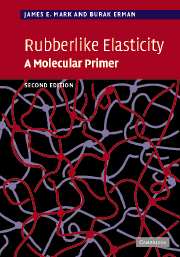Book contents
- Frontmatter
- Contents
- Preface to the first edition
- Preface to the second edition
- Part I Fundamentals
- 1 Introduction
- 2 Some rubberlike materials
- 3 The single molecule: theory and experiment
- 4 Preparation and structure of networks
- 5 Elementary statistical theory for idealized networks
- 6 Statistical theory for real networks
- 7 Elastic equations of state and force–deformation relations
- 8 Swelling of networks and volume phase transitions
- 9 Force as a function of temperature
- 10 Model elastomers
- Part II Additional topics
- Appendix A Relationships between ν, ξ and Mc
- Appendix B Relationships between 〈r2〉, 〈(Δr)2〉, 〈r2〉0, and ϕ
- Appendix C Equations of state for miscellaneous deformations from the constrained junction theory
- Appendix D Thermodynamics of the relationship of stress to temperature
- Problems
- Answers to problems
- Some publications describing laboratory/classroom experiments or demonstrations
- References
- Index
9 - Force as a function of temperature
from Part I - Fundamentals
Published online by Cambridge University Press: 04 December 2009
- Frontmatter
- Contents
- Preface to the first edition
- Preface to the second edition
- Part I Fundamentals
- 1 Introduction
- 2 Some rubberlike materials
- 3 The single molecule: theory and experiment
- 4 Preparation and structure of networks
- 5 Elementary statistical theory for idealized networks
- 6 Statistical theory for real networks
- 7 Elastic equations of state and force–deformation relations
- 8 Swelling of networks and volume phase transitions
- 9 Force as a function of temperature
- 10 Model elastomers
- Part II Additional topics
- Appendix A Relationships between ν, ξ and Mc
- Appendix B Relationships between 〈r2〉, 〈(Δr)2〉, 〈r2〉0, and ϕ
- Appendix C Equations of state for miscellaneous deformations from the constrained junction theory
- Appendix D Thermodynamics of the relationship of stress to temperature
- Problems
- Answers to problems
- Some publications describing laboratory/classroom experiments or demonstrations
- References
- Index
Summary
Introduction
As was illustrated in Chapter 5, one of the most important thermodynamic quantities is the free energy. It is a state function and has been given this particular name because it represents that portion of the energy available (“free”) to do work under specified conditions (Atkins, 1990). The type of free energy used in Chapter 5 is called the Helmholtz free energy A ≡ E − TS, and is most useful under conditions of constant temperature and constant volume. (The fact that the theory proceeds through the Helmholtz free energy complicates things for experimentalists. They must either do the experiment at constant volume, which is very difficult, or correct their constant-pressure data to constant volume, which requires model-based approximations.)
The second type of free energy of interest to physical chemists is the Gibbs free energy, G ≡ H − TS. It is more convenient for analysis of systems at constant temperature and constant pressure. For such a process G must decrease, consistent with nature's attempt to decrease the energy of a system while simultaneously increasing its entropy, or disorder.
Its relevance to rubberlike elasticity can be illustrated by analysis of force–temperature (thermoelastic) measurements (Flory et al., 1960). Such experiments, first described qualitatively in Chapter 1, have now been carried out quantitatively for a wide variety of elastomers. The basic question in this analysis was raised in a preliminary manner in Chapter 7.
Information
- Type
- Chapter
- Information
- Rubberlike ElasticityA Molecular Primer, pp. 79 - 92Publisher: Cambridge University PressPrint publication year: 2007
